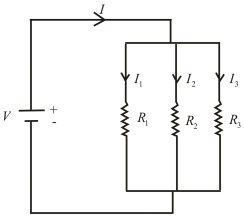
The current passing through each resistor and a parallel circuit combination.
Answer to Problem 1VC
Explanation of Solution
Given info: First resistor having resistance
Explanation:
The figure represents a parallel circuit arrangement. In a parallel circuit three resistors are arranged with their heads connected to head and tails are connected tails across the dc voltage source as shown in below figure.

Formula to calculate the equivalent resistance in a parallel circuit is,
Here,
Substitute
The current passing through a parallel circuit is divided among each resistor.
The expression for the total current passing through each resistor is,
Here,
Write the expression for current in terms of voltage and resistance in a resistor having resistance
Here,
Substitute
Write the expression for current in terms of voltage and resistance in a resistor having resistance
Substitute
Write the expression for current in terms of voltage and resistance in a resistor having resistance
Substitute
The expression for the total current passing through each resistor is,
Substitute
Substitute
Further solve the equation.
Conclusion:
Therefore, the current passing through each resistor is
Want to see more full solutions like this?
Chapter 8 Solutions
An Introduction to Physical Science
 College PhysicsPhysicsISBN:9781285737027Author:Raymond A. Serway, Chris VuillePublisher:Cengage Learning
College PhysicsPhysicsISBN:9781285737027Author:Raymond A. Serway, Chris VuillePublisher:Cengage Learning
 College PhysicsPhysicsISBN:9781938168000Author:Paul Peter Urone, Roger HinrichsPublisher:OpenStax College
College PhysicsPhysicsISBN:9781938168000Author:Paul Peter Urone, Roger HinrichsPublisher:OpenStax College College PhysicsPhysicsISBN:9781305952300Author:Raymond A. Serway, Chris VuillePublisher:Cengage Learning
College PhysicsPhysicsISBN:9781305952300Author:Raymond A. Serway, Chris VuillePublisher:Cengage Learning Physics for Scientists and Engineers, Technology ...PhysicsISBN:9781305116399Author:Raymond A. Serway, John W. JewettPublisher:Cengage Learning
Physics for Scientists and Engineers, Technology ...PhysicsISBN:9781305116399Author:Raymond A. Serway, John W. JewettPublisher:Cengage Learning Physics for Scientists and EngineersPhysicsISBN:9781337553278Author:Raymond A. Serway, John W. JewettPublisher:Cengage Learning
Physics for Scientists and EngineersPhysicsISBN:9781337553278Author:Raymond A. Serway, John W. JewettPublisher:Cengage Learning





